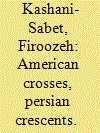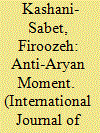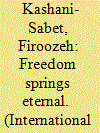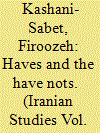|
|
|
Sort Order |
|
|
|
Items / Page
|
|
|
|
|
|
|
| Srl | Item |
| 1 |
ID:
107459


|
|
|
|
|
| Publication |
2011.
|
| Summary/Abstract |
The American public came to know Iran through its missionaries who had lived among the Persians. For their part, Iranians grew familiar with Americans through interactions with these missionary pioneers as well. While American Presbyterians quickly established and expanded their institutional presence in the country, it became abundantly clear to them that Muslim converts to Protestantism remained few and far between. Missionary perceptions of Iranian Muslims, however, left an indelible imprint on American public understanding of Iran and its people. The paper argues that religious ideology frequently colored perceptions and influenced policy-making. Even after more than a hundred years of interaction, cultural representations were refracted through religious difference and similarity. Despite the increasingly secular cultures of Iran and America in the early twentieth century, religion remained a salient ideology for the public in both societies-one that has had a profound impact on the nature of US-Iranian relations. Thus, it is important to analyze the origins and impact of this contact beginning in the nineteenth century.
|
|
|
|
|
|
|
|
|
|
|
|
|
|
|
|
| 2 |
ID:
182847


|
|
|
|
|
| Summary/Abstract |
In 1946, the entertainer and activist Paul Robeson pondered America's intentions in Iran. In what was to become one of the first major crises of the Cold War, Iran was fighting a Soviet aggressor that did not want to leave. Robeson posed the question, “Is our State Department concerned with protecting the rights of Iran and the welfare of the Iranian people, or is it concerned with protecting Anglo-American oil in that country and the Middle East in general?” This was a loaded question. The US was pressuring the Soviet Union to withdraw its troops after its occupation of the country during World War II. Robeson wondered why America cared so much about Soviet forces in Iranian territory, when it made no mention of Anglo-American troops “in countries far removed from the United States or Great Britain.” An editorial writer for a Black journal in St. Louis posed a different variant of the question: Why did the American secretary of state, James F. Byrnes, concern himself with elections in Iran, Arabia or Azerbaijan and yet not “interfere in his home state, South Carolina, which has not had a free election since Reconstruction?”
|
|
|
|
|
|
|
|
|
|
|
|
|
|
|
|
| 3 |
ID:
112180


|
|
|
|
|
| Publication |
2012.
|
| Summary/Abstract |
Revolutions are chaotic affairs. In February 1979, when Ayatollah Khomeini and his followers declared victory, Iran's future seemed uncertain. After a long night of hostility and bloodshed, an eerie silence fell on Tehran, and in some corners fear supplanted exhilaration. Those of us who witnessed these historic events did not fully fathom what Islamic politics augured. Within weeks, on the occasion of International Women's Day, it became clear that women had become targets of the regime's cultural indoctrination. Other matters remained murky for months and would play out gradually in the first decade after the revolution.
|
|
|
|
|
|
|
|
|
|
|
|
|
|
|
|
| 4 |
ID:
110878


|
|
|
|
|
| Publication |
2010.
|
| Summary/Abstract |
This essay provides a historical analysis of Iranian experiences with disability. I will begin by reviewing the literary application of the term in various contexts. Next, I will examine the social milieux in which local observers, medical professionals, and policy makers talked about and treated disability. As state-run institutions emerged to address disability needs, health professionals often drew a distinction between physical disability and intellectual or psychological disability, raising ethical and legal questions about the status of the disabled in modern Iranian society. Finally, an attempt will be made to situate disability politics in contemporary Iran, where the disabled population has increased significantly as a consequence of the Iran-Iraq War (1980-88). Although this paper concentrates on Iranian experiences with disability, comparisons can be drawn with other Islamic societies.
|
|
|
|
|
|
|
|
|
|
|
|
|
|
|
|
| 5 |
ID:
192264


|
|
|
|
|
| Summary/Abstract |
Iran’s simultaneous relations with Israel and the Arab world have received insufficient scholarly attention. After the Second World War, Iran accustomed itself to the shifting power plays in the Middle East. The thirty years between 1945–1975 witnessed the waning of Iran’s influence in the Persian Gulf and the rise of Egypt, Israel, and Saudi Arabia. During much of the Nasser era, until Egypt’s defeat in 1967, Iran’s relationship with Egypt remained tense. Fervent Arab nationalist ideologies identified the shah’s Iran as a state aligned firmly with the West. Iran’s support for Israel became a frequent negative target of the Arab press. In the Persian Gulf, however, Iran did not see eye-to-eye with America or Britain and tried to forge a separate path with Saudi Arabia and the newly configured countries. Iran had to tread gingerly to maintain amicable relations with its neighbors. In the end Iran could only adequately safeguard its security as its regional isolation became the new reality.
|
|
|
|
|
|
|
|
|
|
|
|
|
|
|
|
|
|
|
|
|